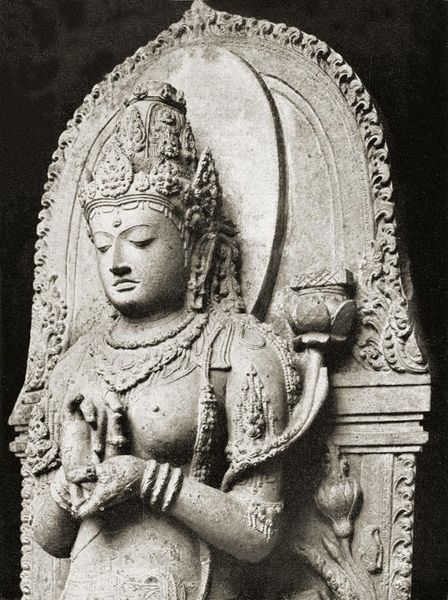return to Home Page
or move on to Goddess Prakrti, next chronologically,
or use Her Cyclopedia Index
Prajnaparamita, Wisdom-of-the-Yonder-Shore.
PR1JN*P*R*MYT1
[to Whom the third day of July, day 184, is dedicated]

return to Home Page
or move on to Goddess Prakrti, next chronologically,
or use Her Cyclopedia Index
Prajnaparamita, Wisdom-of-the-Yonder-Shore.
PR1JN*P*R*MYT1
[to Whom the third day of July, day 184, is dedicated]

Geography/Culture: Hindustani. [?\gds\gazeteer\gazeteer.3a]: Tantric Buddhist.
Linguistic Note: prajna is constantly translated as 'wisdom'. Paramita is more confused {am pretty certain the meaning above is from Campbell}, sometimes 'book' is implied, sometimes 'virtue', as in ". . . the first of ten Buddhist virtues, the Paramitas: Dana-Paramita, the virtue of compassion."
Description: Goddess of serenity; She Who represents the fulfillment and bliss of the transcendental sphere; She Who sends enlightening rays of release from the limiting ego-consciousness; Embodiment of the Fivefold Transcendent Wisdom; Mother of all Buddhas; Matron of philosophers and those who still seek wisdom; She Who is venerated as representative of all the great virtues, the highest of which is wisdom.
To Whom Sacred: the pink lotus (on which She sits, or which unfolds behind Her); book of wisdom (which sometimes seems to be called prajnaparamita); the mudra, 'link of increase', or 'juncture', in which the touching together of the middle finger-tips symbolizes the coincidence of opposites (ie of heaven and earth); the teaching mudra (possible the same as the last); the zenith.
White-Tara.
Geography/Culture: Hindustani: Tantric Buddhist.
Description: Goddess of transcendental knowledge and {teaching?}; Goddess of the end of life when the sacrificial victim is beheaded.
To Whom Sacred: the pink lotus.
Iconography: She holds stem of a pink lotus.
Male Associate: Nisumbha, ----, whom She slew.
Vajrayogini, V1gR*YOGYNE, {The-Power-of-Two}, is iconographically similar.
Vidya, VYDY*, Knowledge.
Geography/Culture: Buddhist. With the rise of Mahayana and Vajrayana Buddhism in the fifth through seveth centuries CE.
Description: Goddess; the sometimes wrathful, passive Female Principle; Embodiment of highest comprehension and transcendent wisdom.
To Whom Sacred: blue lions (which symbolize prajna, transcendent wisdom).
Male Associates: consort to buddhas and bodhisattvas.
Sherchinma.
Geography/Culture: Tibet: Tibetian Buddhist.
Description: Great Mother; Primordial Energy out of which all the manifold emanations are born; Mystic Consort; She Who entwined about Her consort represents the inseparability and unity of archaic contrasts; She Who shows the path to the comprehension of the Absolute Truth, beyond all prejudices arising from limited physical and psychical perceptions, and wrong conceptions, which must be discarded like old clothes.
To Whom Sacred: the Mahamudra, 'the Great Seal' (the Father-Mother position, Yab-Yum, symbol of the unity of contrasts melting into Oneness at the highest level of comprehension); sceptre and bell (a small symbol of the Twin-unity of Contrasts which repeats the Great Pose); sun and moon (when shown together as two disks, repeats the Great Pose).
Iconography: She may have two, six, or eight arms holding various significant objects such as the skull cup, the small tantric double drum, the short trishula, (trident adorned with skulls), flaming jewel, lotus flower, sword, battle-axe, thunderbolt; She sits in the lap of Her Yab, with Her arms about his neck; or She has Her left leg around his right hip; or both Her legs cling round his loins; She may be naked, bare of worldly trifles (signifying void of all illusions).
Male Associates: consort Yab, Father, a term for the Dhyani-Buddhas, when in Her embrace. He signifies 'method' to Her 'wisdom'.
Rigs-Ma, RYGS-M*, Mystic-Consort.